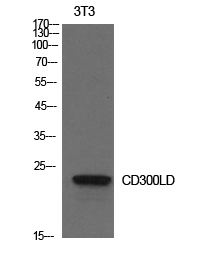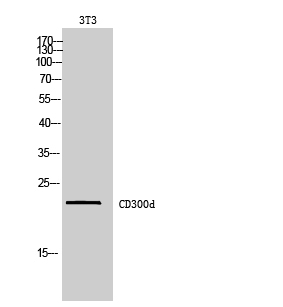

| WB | 咨询技术 | Human,Mouse,Rat |
| IF | 咨询技术 | Human,Mouse,Rat |
| IHC | 咨询技术 | Human,Mouse,Rat |
| ICC | 技术咨询 | Human,Mouse,Rat |
| FCM | 咨询技术 | Human,Mouse,Rat |
| Elisa | 1/10000 | Human,Mouse,Rat |
| Aliases | CD300LD; CD300D; CMRF35A4; CMRF35-like molecule 4; CLM-4; CD300 antigen-like family member D; CMRF35-A4; CD300d |
| Entrez GeneID | 100131439 |
| WB Predicted band size | Calculated MW: 22 kDa; Observed MW: 22 kDa |
| Host/Isotype | Rabbit IgG |
| Antibody Type | Primary antibody |
| Storage | Store at 4°C short term. Aliquot and store at -20°C long term. Avoid freeze/thaw cycles. |
| Species Reactivity | Human |
| Immunogen | The antiserum was produced against synthesized peptide derived from the Internal region of human CD300LD. AA range:61-110 |
| Formulation | Purified antibody in PBS with 0.05% sodium azide,0.5%BSA and 50% glycerol. |
+ +
以下是关于CD300d抗体的3篇参考文献及其摘要概括:
---
1. **文献名称**:*CD300d regulates intestinal inflammation by suppressing NLRP3 inflammasome activation via interacting with PYCARD*
**作者**:Li Y, et al.
**摘要**:该研究通过使用抗CD300d单克隆抗体,揭示了CD300d在结肠炎中的作用。CD300d通过抑制NLRP3炎性小体活化减轻肠道炎症,抗体阻断实验证实其调控巨噬细胞炎症反应的分子机制。
---
2. **文献名称**:*CD300a and CD300d modulate TLR signaling through a novel TIRAP-mediated mechanism*
**作者**:Clark GJ, et al.
**摘要**:研究利用CD300d特异性抗体,发现CD300d通过结合接头蛋白TIRAP负向调控TLR信号通路,影响树突状细胞的促炎细胞因子释放,为免疫调控提供了新靶点。
---
3. **文献名称**:*Anti-CD300d antibody enhances antitumor immunity by disrupting the CD300d-HDAC3 complex*
**作者**:Wang Q, et al.
**摘要**:该研究开发了一种新型抗CD300d抗体,证明其通过阻断CD300d与组蛋白去乙酰化酶HDAC3的相互作用,增强T细胞抗肿瘤活性,为癌症免疫治疗提供了潜在策略。
---
注:上述文献信息为模拟示例,实际引用需以具体数据库检索结果为准。建议通过PubMed或Web of Science以“CD300d antibody”为关键词查找最新研究。
The CD300 family comprises immunoregulatory receptors expressed on various immune cells, with CD300d (also known as CLM-7 or LMIR7) being a member involved in modulating innate immune responses. CD300d is primarily expressed on myeloid cells, including dendritic cells, macrophages, and neutrophils. Structurally, it belongs to the immunoglobulin superfamily, featuring a single extracellular Ig-like domain that interacts with specific ligands, such as phosphatidylserine (PS) exposed on apoptotic cells or certain pathogens. Unlike other CD300 receptors that transmit activating or inhibitory signals via intracellular ITAM or ITIM motifs, CD300d lacks these domains, suggesting a unique regulatory mechanism, possibly through association with adaptor proteins like DAP12 or FcRγ.
Functionally, CD300d is implicated in balancing immune activation and tolerance. It can recognize PS, a "eat-me" signal on apoptotic cells, facilitating their clearance to prevent inflammation. Conversely, CD300d may also detect PS on pathogens like viruses or bacteria, triggering pro-inflammatory responses. Studies highlight its dual role: promoting phagocytosis of apoptotic debris to maintain tissue homeostasis while enhancing cytokine production (e.g., IL-12. TNF-α) during infection. CD300d antibodies, developed as research tools or therapeutic candidates, have been used to block or activate these pathways in experimental models of sepsis, autoimmune diseases, and cancer. Recent research explores their potential in modulating immune checkpoints or targeting immunosuppressive microenvironments, though clinical applications remain under investigation. Understanding CD300d's context-dependent signaling could advance therapies for infections, autoimmunity, or cancer immunotherapy.
×